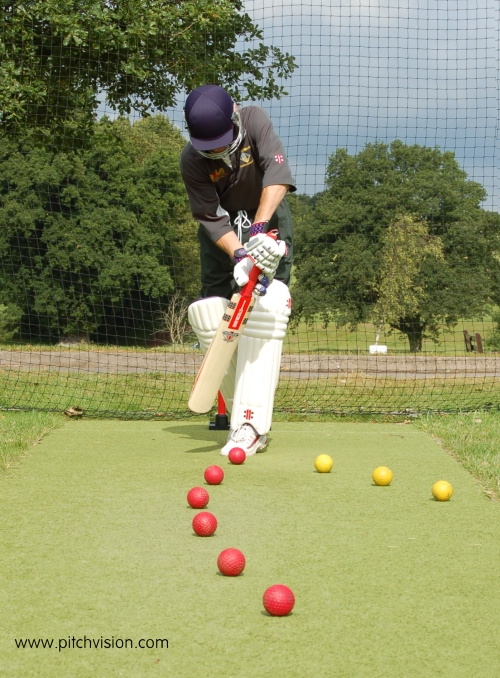Why you struggle against left arm bowling
This is part 1 of a 2 part series by Gary Palmer about batting against left arm over bowlers.
The most successful batsmen have efficient techniques against all angles and types of bowler.
Lesser players struggle against left arm over pace bowling, especially the ones who swing the ball back in to the batter. This problem is apparent with all ages and standards of cricketers.
Players develop their technique against right arm over bowling, throw drowns and the bowling machine from the same angle. Too often we neglect the left arm over angle.
Yet practicing this angle can identify flaws in technique that are not so obvious when facing the right arm over angle.
Better players make batting look easier by practicing in more detail.
Common faults
Practicing will help you remove some of the common faults that make it difficult to play the left arm pace bowler who swings the ball back into the right hander:
Not opening your stance: From an orthodox stance you are partially blocked off before you even begin to play a shot. This is where it all begins the process of tipping to the offside, being blocked off and playing around the front pad like in this picture:

Keeping your backswing too straight: This means the bat has to swing like a golf swing to get at the ball and therefore the batter plays across the line and ends up too chest on. At the point of contact you will be to side on and therefore blocked off and in a poor position to access the ball:

Front and/or back foot lands too sideways: This makes the batter blocked off once again because the hips are too sideways thus limiting your reach and balance.
Too much bottom hand in the drives: Causing hitting across the line.
Too big a stride: Limits the batters ability to let the ball come and adjust as the ball swings in.
Trying to make contact with the ball level with the front foot: Minimises the amount the player can get his head forward and inhibits leaning in to the shoot.
Hitting the on drive by the side of the foot: Causes poor balance and alignment and the result is tipping to the off side
Hitting straight and on drives with the front foot across the line of the back foot: This causes poor alignment and poor balance.
Putting the front foot outside the line of leg stump when playing the on drive: This results in tipping to the off side and trying to play the ball to square on the offside.
Now you know how to practice and what to look for. In part 2 we will examine the correct technical point to work on when you are in the nets. To go to part 2 click here.
- Login to post comments


Comments
Does it make sense to transfer the weight initially on to the backfoot (without moving the backfoot back and across) and waiting for the ball to come further and then put the frontfoot forward? I have seen Tendulkar do the same. He kind of makes an initial front foot movement (but doesnt plant his foot down the track - the weight is on the backfoot itself), waits for the ball to swing and then adjusts his foot movement according to the swing. May be he has the advantage of a low centre of gravity and execptional balance and lesser mortals would struggle to copy it. Does this method makes sense at all or I am reading too much into what I see on TV?
"Too big a stride" - could someone elaborate on that? I've never faced a lefty in a game but we have one in our team who has bowled me a couple of times when I *thought* I was doing everything right (wasn't falling sideways, seemed be balanced even after being bowled), but certainly took a big-ish stride out (on drive) to get to the pitch of the ball as I thought we were *supposed* to do?! Cheers.
Oh My God
Thank You Very much Sir David and Sir Gary
This is my biggest problem in batting, I will read article (both parts) by heart and try to follow your instuructions.
Thanks
i have been suffering from those problems especially in selections..but now when i saw you doing this safely i have no dought........picth vision is a great site and shows us very important things and give more knowlede about cricket...thank you gary sir for all his cricket advise and david sir for all your guidance and spending your time for us......
Batting against left handed bowling - or a right hander going round the wicket - requires no special technique. It should be an absolute no brainer that if the guy is bowling from a different angle, you need to turn your stance round so you're facing him again. I find it hard to believe that a batsman could have failed to work this out for himself.
In answer to Barnes - most batsman use a trigger movement when facing pace bowling, the most common one being the back and across move that you noticed in Tendulkar. It makes no difference whether the bowler is left handed or right handed.
I agree AB, but many do fail to realise to open their stance. But as you say, it doesn't require a different technique, it just greater exposes flaws in technique that are already there.
I think right handed batsmen should always be having a tough time facing a left handed bowler as he always tend to ball in an inwards manner, which limits the space for batsmen to play good beverly diamonds reviews shots.